 |
||
|
||
| ||
TABLE OF CONTENTS
Indeed, more attention has been paid to PCI-Express of late. That's quite reasonable, it's the future. However, the market share of AGP platforms (and consequently of the corresponding video cards) is still rather large, so it's too early to write off this segment. Moreover, it also requires new products, especially in those price segments, which hadn't enjoyed them for a long time. I am not going to describe the mistake made by Canadian ATI Technologies a year ago, when it had started totally ignoring AGP video cards in the price segment within 130 - 300 USD. The aftershock has come only recently in the form of losses in the fiscal quarter balance. This spring the company suddenly woke up and released new AGP solutions (counterparts of the not-so-new PCI-Express models) based on the PCIE-to-AGP RIALTO bridge. Judging from the weak demand for these cards, we can draw a conclusion that the company was late. The pie is already divided and served out. Even the X800 AGP cards are of little interest, because most users in this sector already have GeForce 6800/6800LE. If we go down to the prices from $150 to $190, or even from $120 to $190, ATI is a bit low on this segment now: the RADEON 9800 PRO has already done its time, its price is evidently not adequate to its features, the GeForce 6600GT is superior in every respect. The 9600XT is too weak for modern games and must go down below $100. So what's left between them? - Nothing. However, Canadian strategists don't get disheartened. They let the 9800 PRO "inhabit" this sector, to be gradually pushed down by the X800 AGP. They even cancelled the X700 AGP release. Their plan is simple: the AGP segment will shrink significantly before the new cards come out; only Low-End video cards will still be in demand and there is plenty of old solutions in this sector. However, the company made a mistake again. But now it had to do with its partners. Well, if the Canadian company doesn't care about profits from the 120-170 USD sector (AGP video cards), its partners still care. They want to make money as long as possible, till there is any demand in this sector. Thus there appeared X700 AGP video cards, manufactured without ATI (does the company from Toronto sell chips and bridges separately? - It does. Well, designing a PCB with a 128bit bus taking into account the RIALTO bridge is not at all difficult). Thus, there appeared the X700 AGP in the 120-140 USD segment, and the 150-180 USD niche got occupied by the X700 PRO AGP. Let's review both cards. Unfortunately we didn't manage to get the products with the same memory size. I repeat that now almost all articles will include video clips, which will be brief but more illustrious concerning new products. There will be three formats: the best quality (MPEG1), average and low quality (WMV). So,
Remember that the RADEON X700 is actually a middle end product, it supports only a 128-bit bus (well, you can also downgrade it to 64 bits), 8 pixel and 4 vertex pipelines, and DirectX 9.0c.
Video Cards
As you can see, both cards are similar in design, which is almost a complete copy of the reference card with PCIE interface. You should understand that the differences have to do only with the PCIE-to-AGP bridge, which is required by the X700-based cards to be used in AGP platforms. Interestingly, these are the first video cards using GDDR3 memory from Infineon that we have seen. They usually use memory chips from Samsung. And the most important thing! I will type it in bold! AS THESE CARDS ARE NOT REGULATED BY ATI, USERS MAY ENCOUNTER VIDEO CARDS WITH DIFFERENT MEMORY CLOCKS UNDER THE SAME NAMES! PLEASE, BEAR IT IN MIND! EVEN NOW WE CAN SEE THAT THE X700 AGP FROM POWERCOLOR OPERATES AT 400/533 MHz INSTEAD OF 400/700 MHz! MOREOVER, THERE HAVE ALREADY APPEARED SIMILAR PRODUCTS FROM OTHER COMPANIES WITH TSOP MEMORY ONLY AT 500 MHz. As we can see, the product from GeCube offers even improved characteristics of its PCI-E counterpart, being clocked at 425/900 MHz instead of 425/860 MHz.
Let's proceed with the examination.
As the AGP interface cannot conduct high power, video cards require external power supply. That's why they are equipped with the corresponding connector (the X700 PCI-E does not need it).
Both products are equipped with GPU RV410 (X700), which operates at different clocks.
Bundle
Let's have a look at the boxes.
Installation and DriversTestbed configurations:
VSync is disabled.
Test results: performance comparisonWe used the following test applications:
If you want to get the demo-benchmarks, which we use, contact me at my e-mail. Overall performanceGame tests that heavily load pixel shaders 2.0.TR:AoD, Paris5_4 DEMO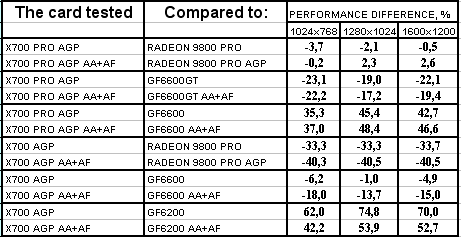 We use this outdated and not very popular game as an example of a classic "shader game", which heavily loads these units. You can easily see that the X700 PRO is right between the 6600GT and the 6600, while the X700 is slightly outperformed by the 6600, but heavily outscores the 6200. The effect of the 256bit bus in the 9800PRO is also noticeable: even though it has lower clock and consequently lower peak fill rate than in the X700/PRO, the latter is heavily outperformed anyway.
Game tests that heavily load vertex shaders, mixed pixel shaders 1.1 and 2.0, active multitexturing.FarCry, Research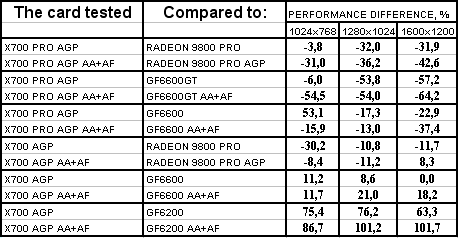 FarCry, Regulator
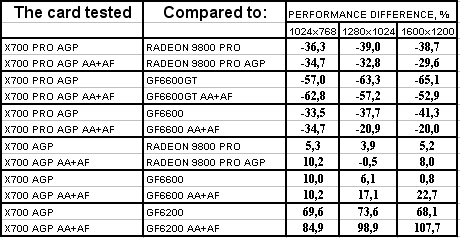 FarCry, Pier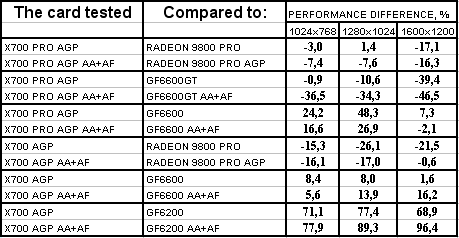 Well, the X700 PRO is outperformed by all video cards. Alas, if a product is outperformed in such a popular and demonstrative game, there may be no consolation. Even the 9800 PRO turned out faster than both our cards. Then. DON'T BE SURPRIZED that the X700 PRO performance is sometimes LOWER than in the X700. I rechecked this nonsense, the results were the same. Yep, the problem obviously lies in the drivers. At the same time, the X700 is not so bad, it outperforms the 6200 and sometimes even the 6600. The X700 PRO prices should be reduced according to the results of our tests.
Game tests that heavily load both vertex shaders and pixel shaders 2.0Half-Life2: ixbt01 demo
 Half-Life2: ixbt02 demo
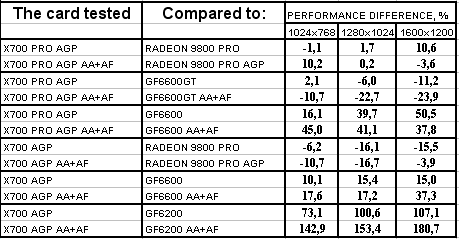 Half-Life2: ixbt03 demo
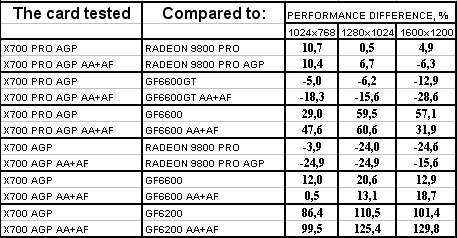 The situation is contradictory. But on the whole we can see that the X700 PRO occupies a fitting place between the 6600GT and the 6600. But the X700 is more divisive.
Game tests that heavily load pixel pipelines with texturing, active operations of the stencil buffer and shader unitsDOOM III High mode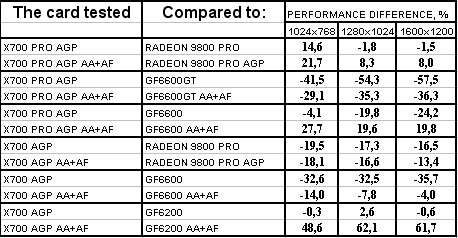 Chronicles of Riddick, demo 44
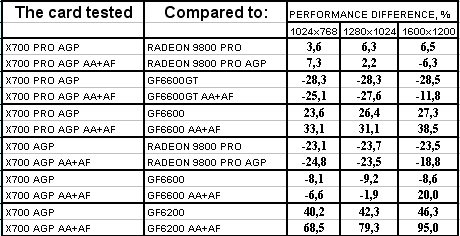 Chronicles of Riddick, demo ducche
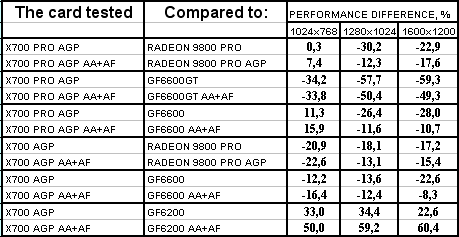 NVIDIA video cards are traditionally superior in these tests due to more flexible and optimal operations of pixel shaders and shading procedures. In this case the situation is the same. Only the 6200 with four pipelines is fairly behind the X700.
Synthetic tests that heavily load shader units3DMark05: MARKS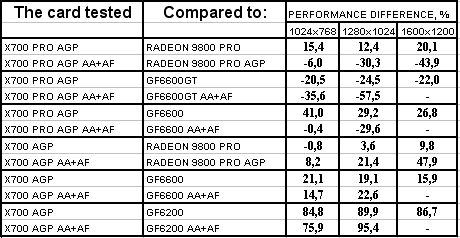 The results are similar to those demonstrated in the first test. That's only natural, considering that the heaviest load falls on shader units again.
ConclusionsOn the whole, it would be hard to draw final conclusions due to an indefinite price range of these cards. ATI does not regulate these cards at all, so each manufacturer will determine the price on its own. But such products already appear on the shelves (by the way, besides the two above-mentioned companies, X700 AGP is also manufactured by Sapphire), and their prices show that they may be quite popular.
You shouldn't forget that one and the same name (X700) may be used by accelerators with memory frequencies from 250 MHz to 350 MHz! It will certainly influence their performance! Today, we have reviewed a middle-of-the-road product.
You can find more detailed comparisons of various video cards in our 3Didest.
Theoretical materials and reviews of video cards, which concern functional properties of the GPU ATI RADEON X800 (R420)/X850 (R480)/X700 (RV410) and NVIDIA GeForce 6800 (NV40/45)/6600 (NV43)
Write a comment below. No registration needed!
|
Platform · Video · Multimedia · Mobile · Other || About us & Privacy policy · Twitter · Facebook Copyright © Byrds Research & Publishing, Ltd., 1997–2011. All rights reserved. | ||||||||||||||||||||||||||||||||||||||||||||||||||||||||||||||